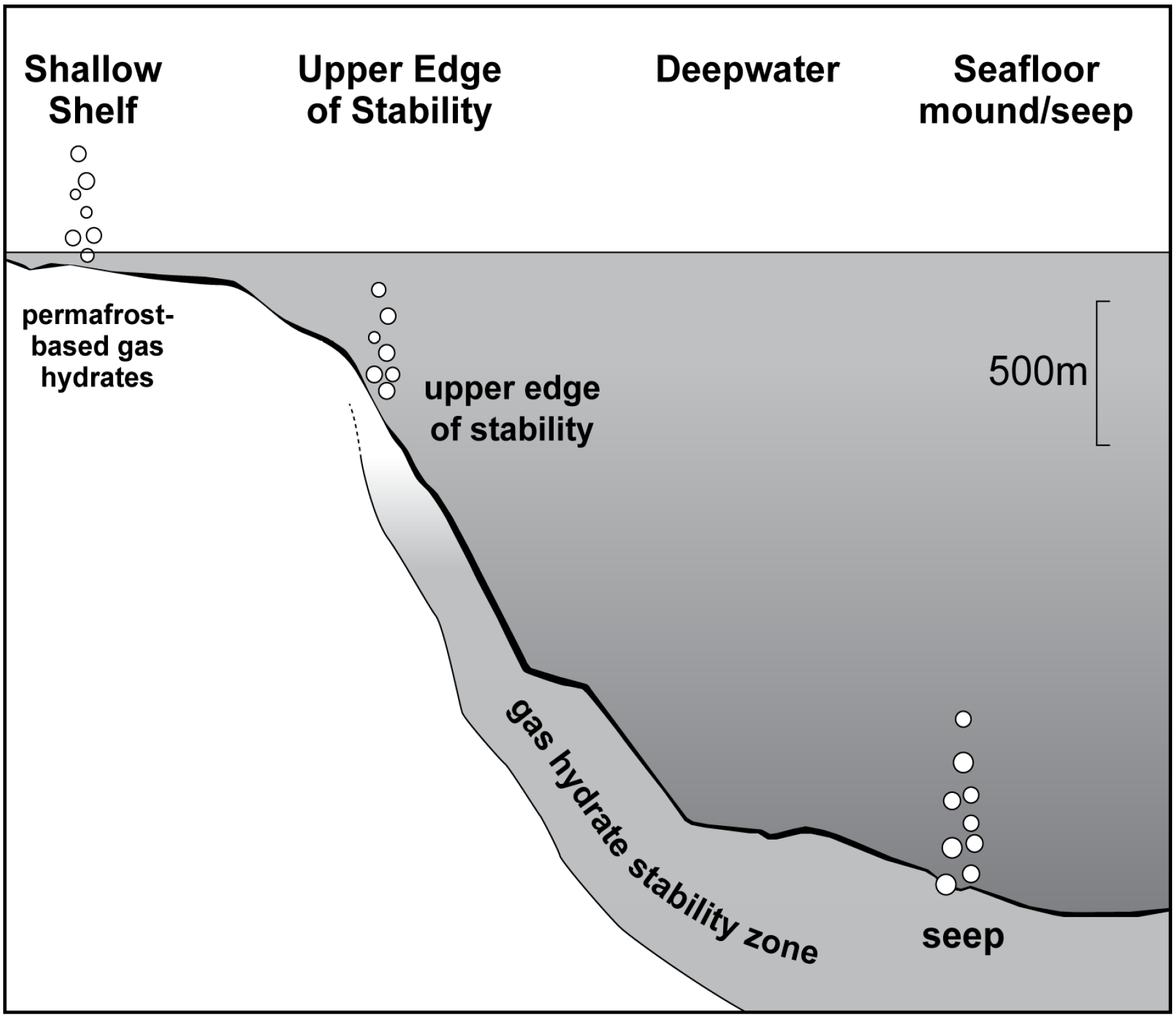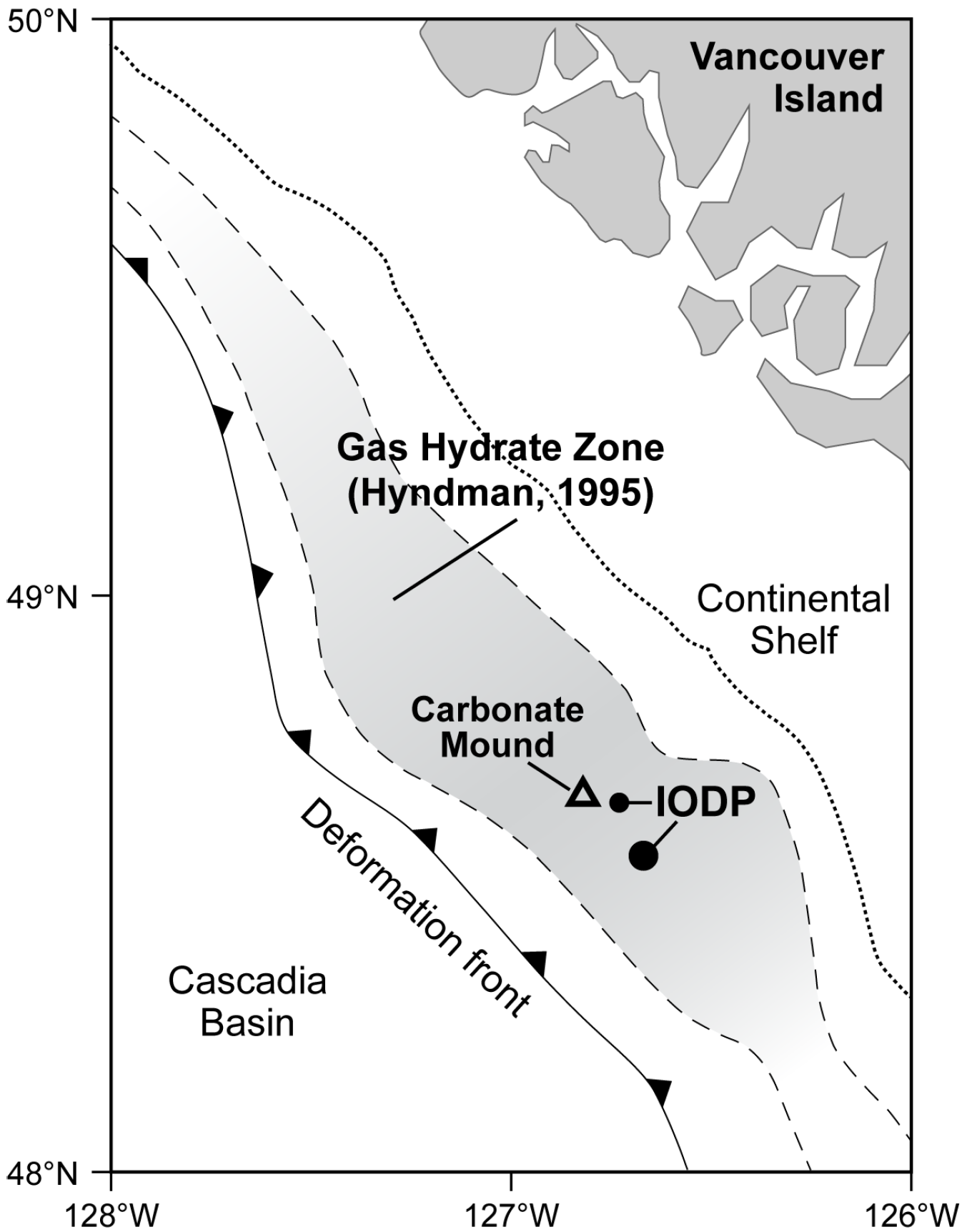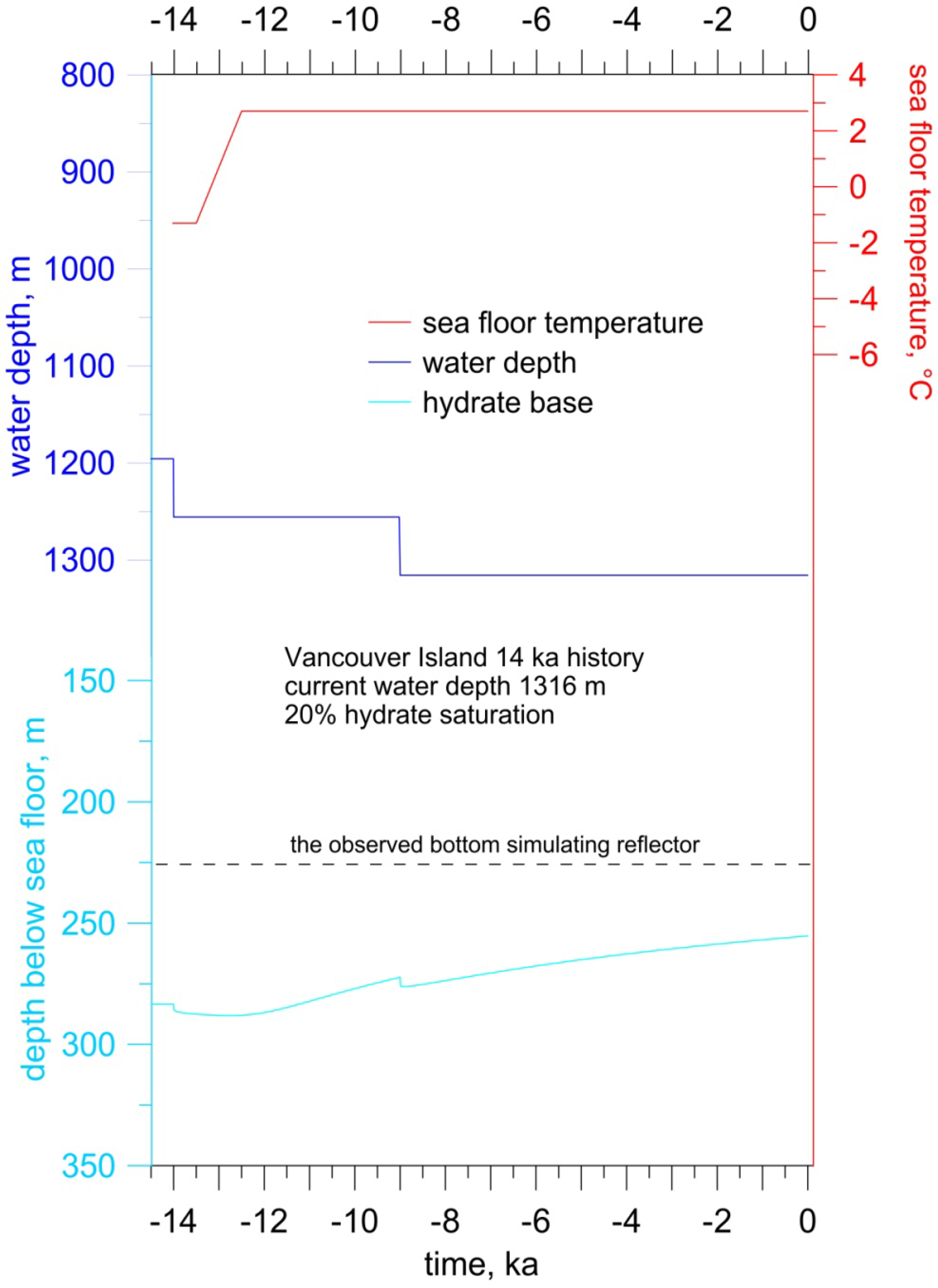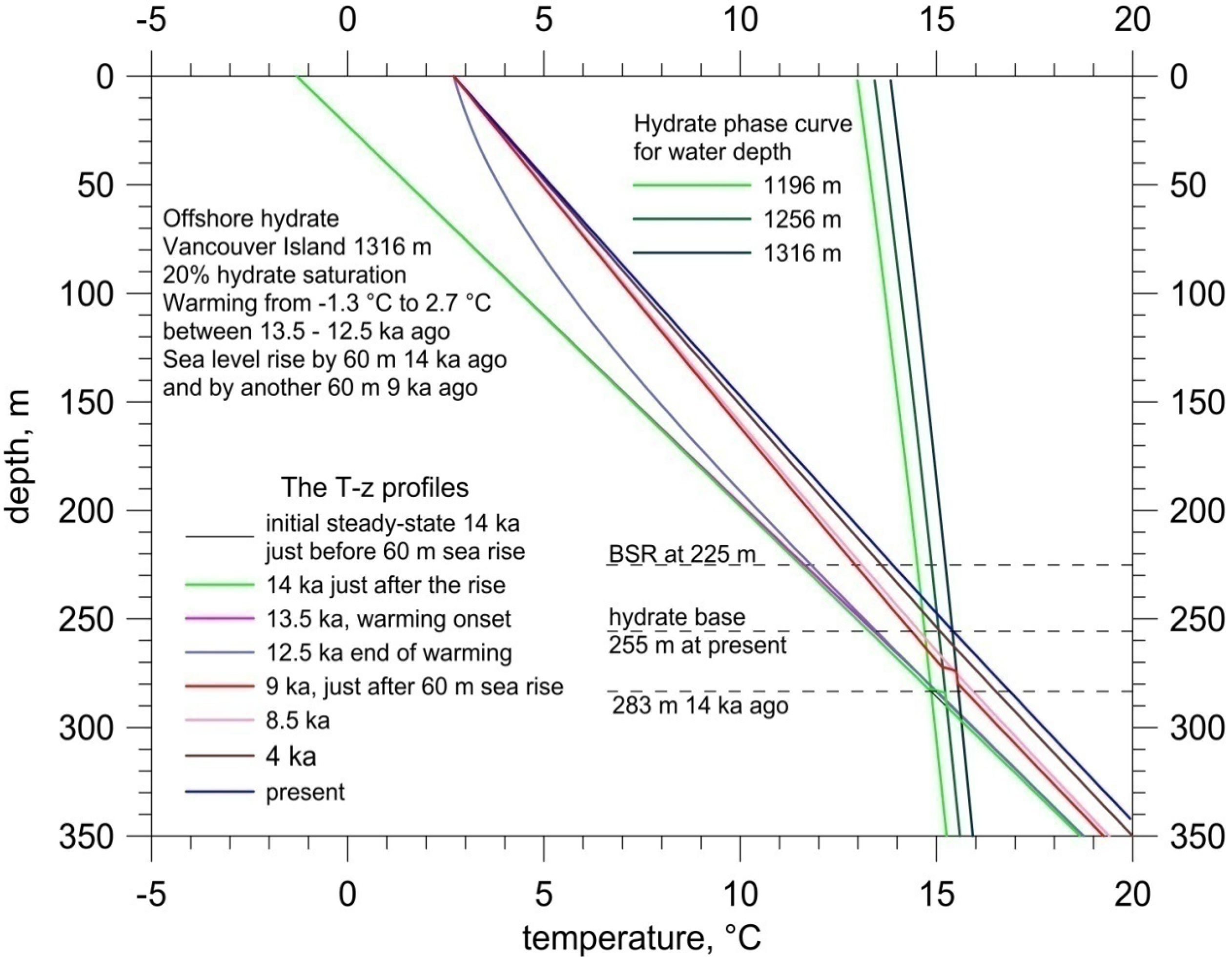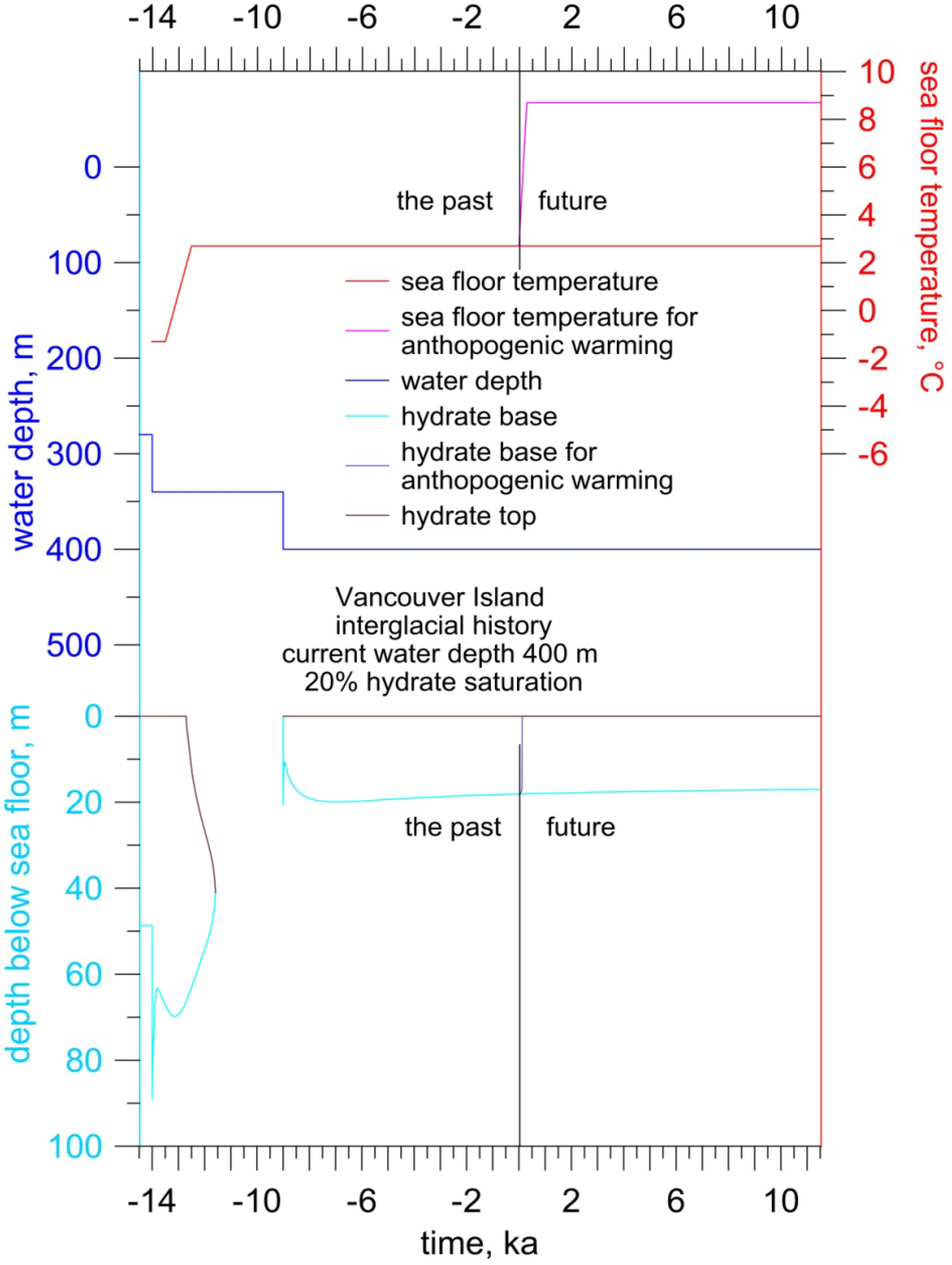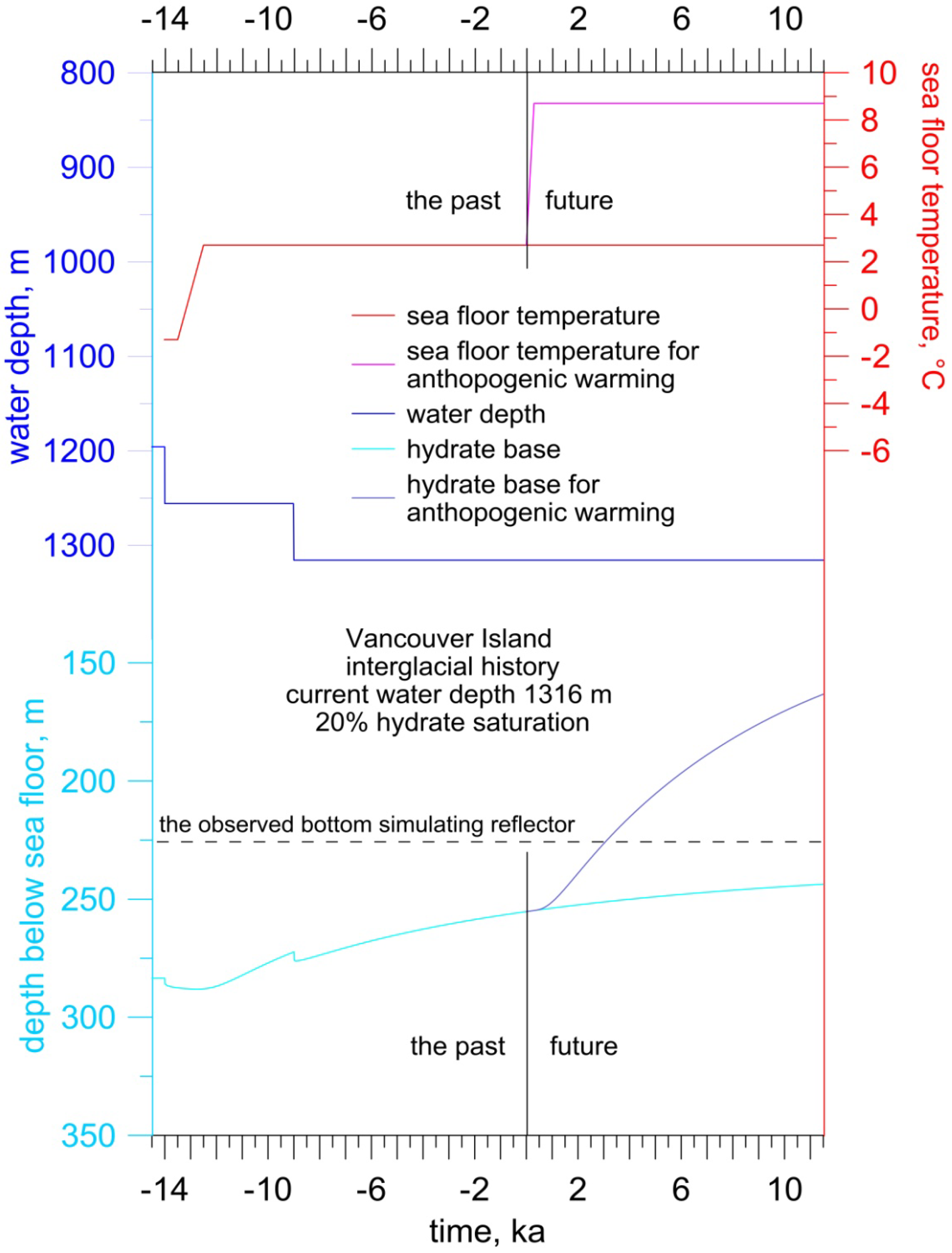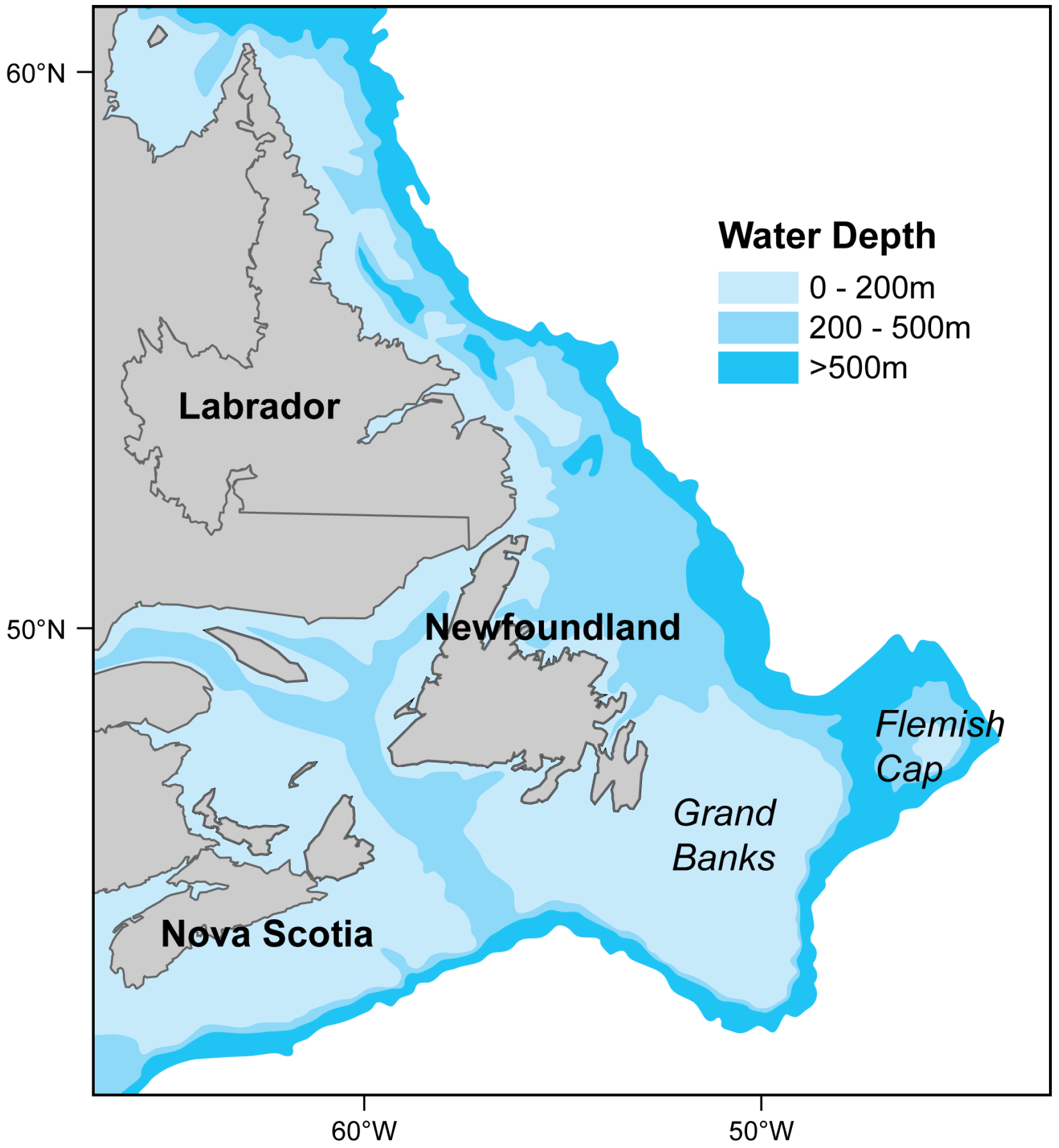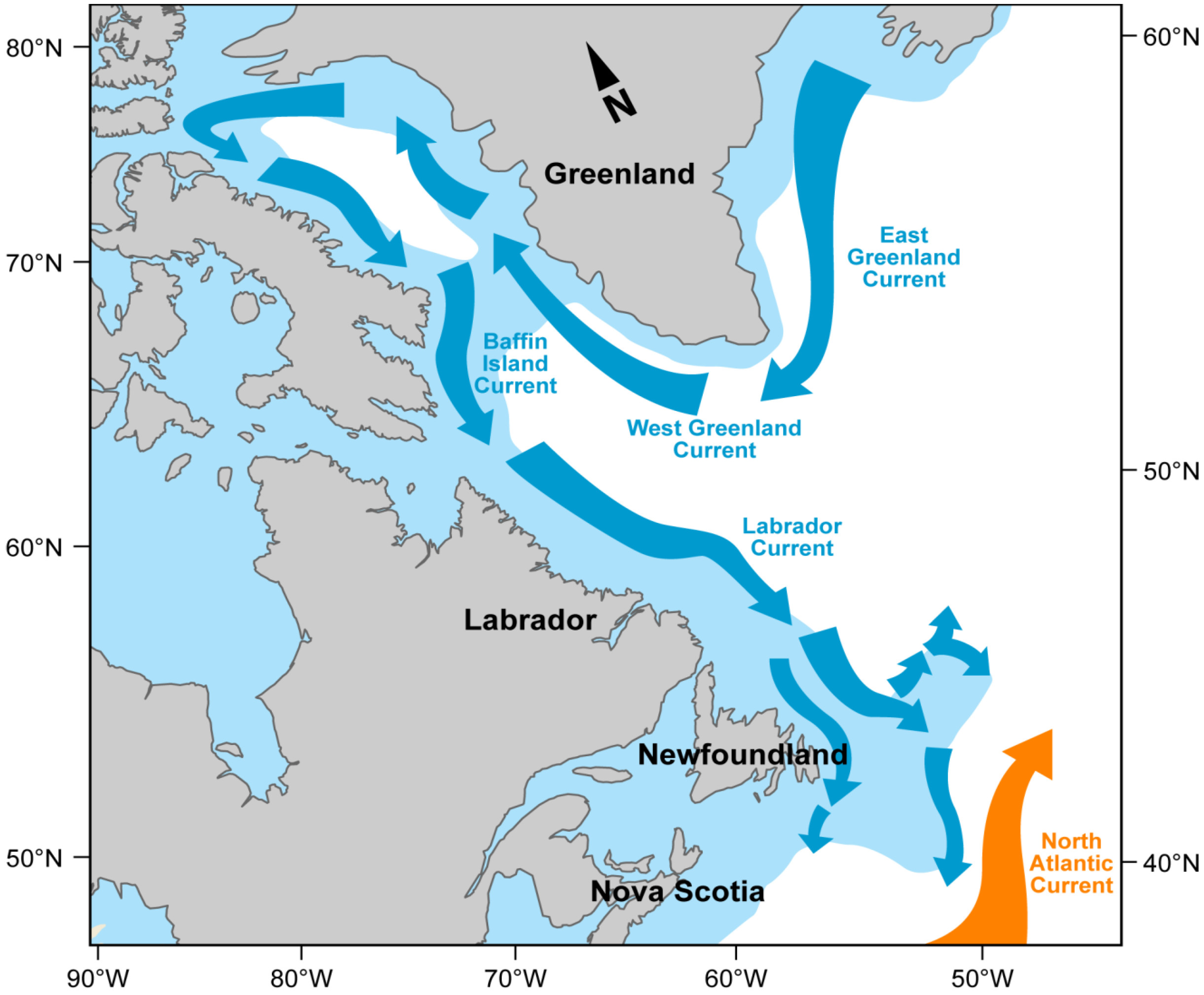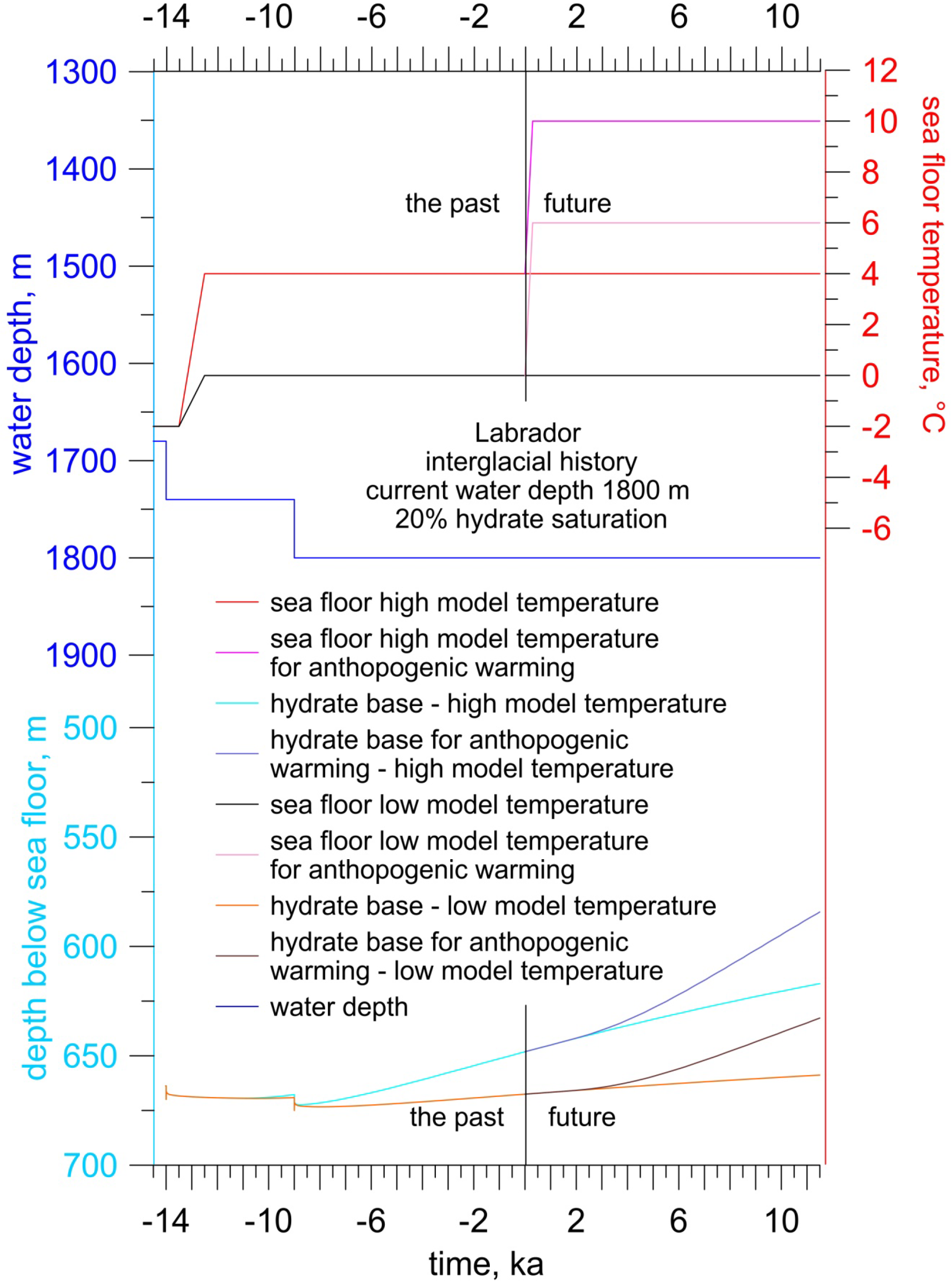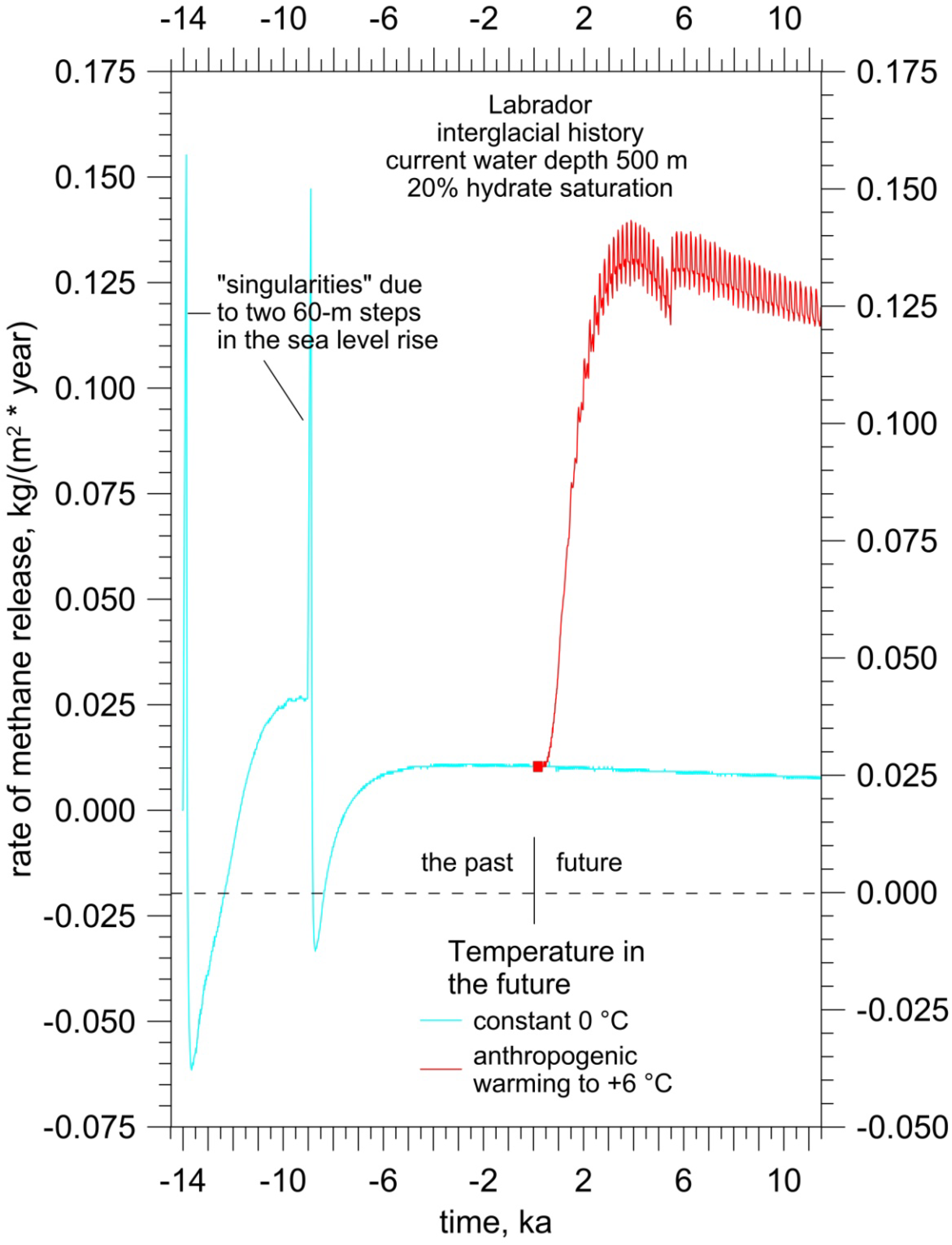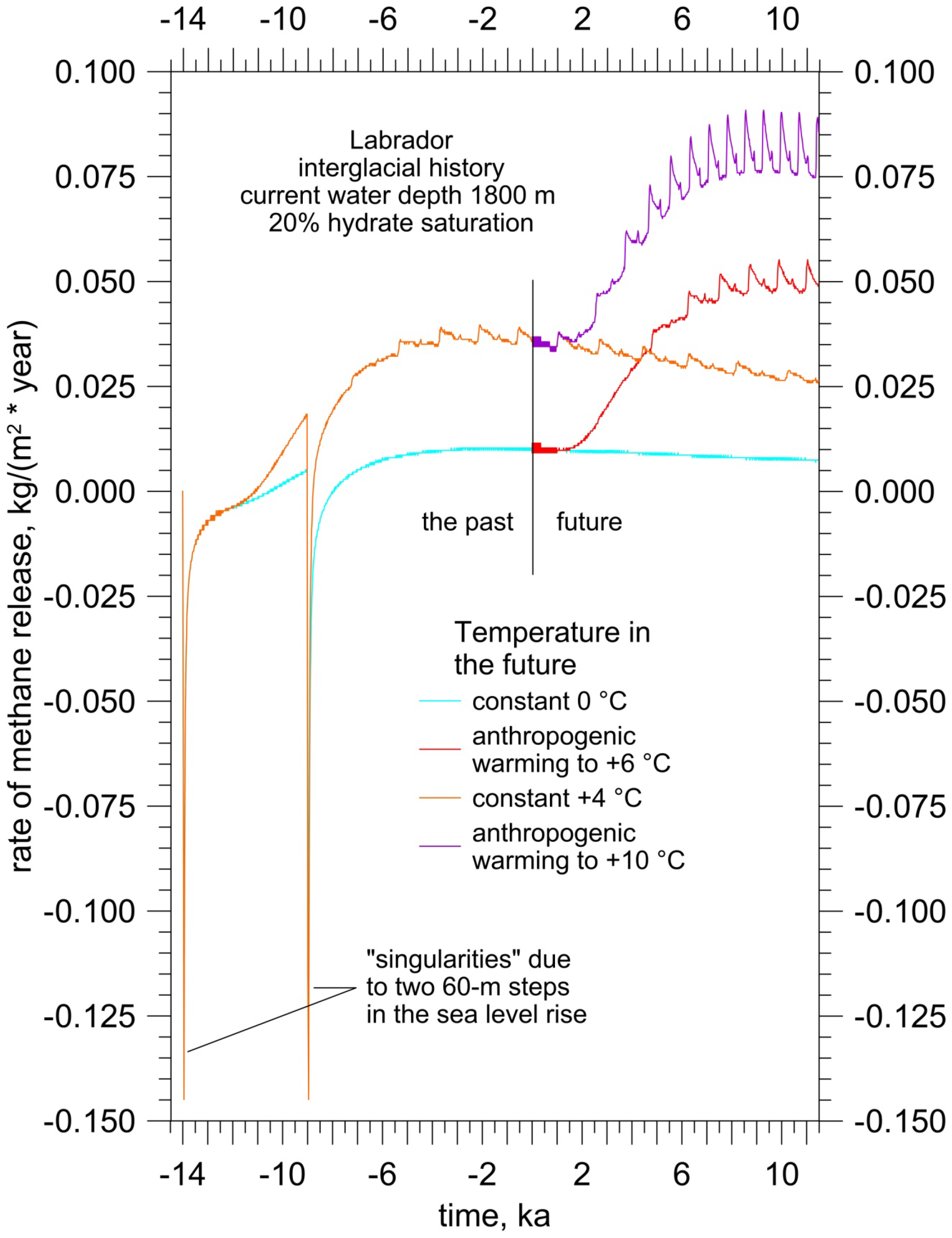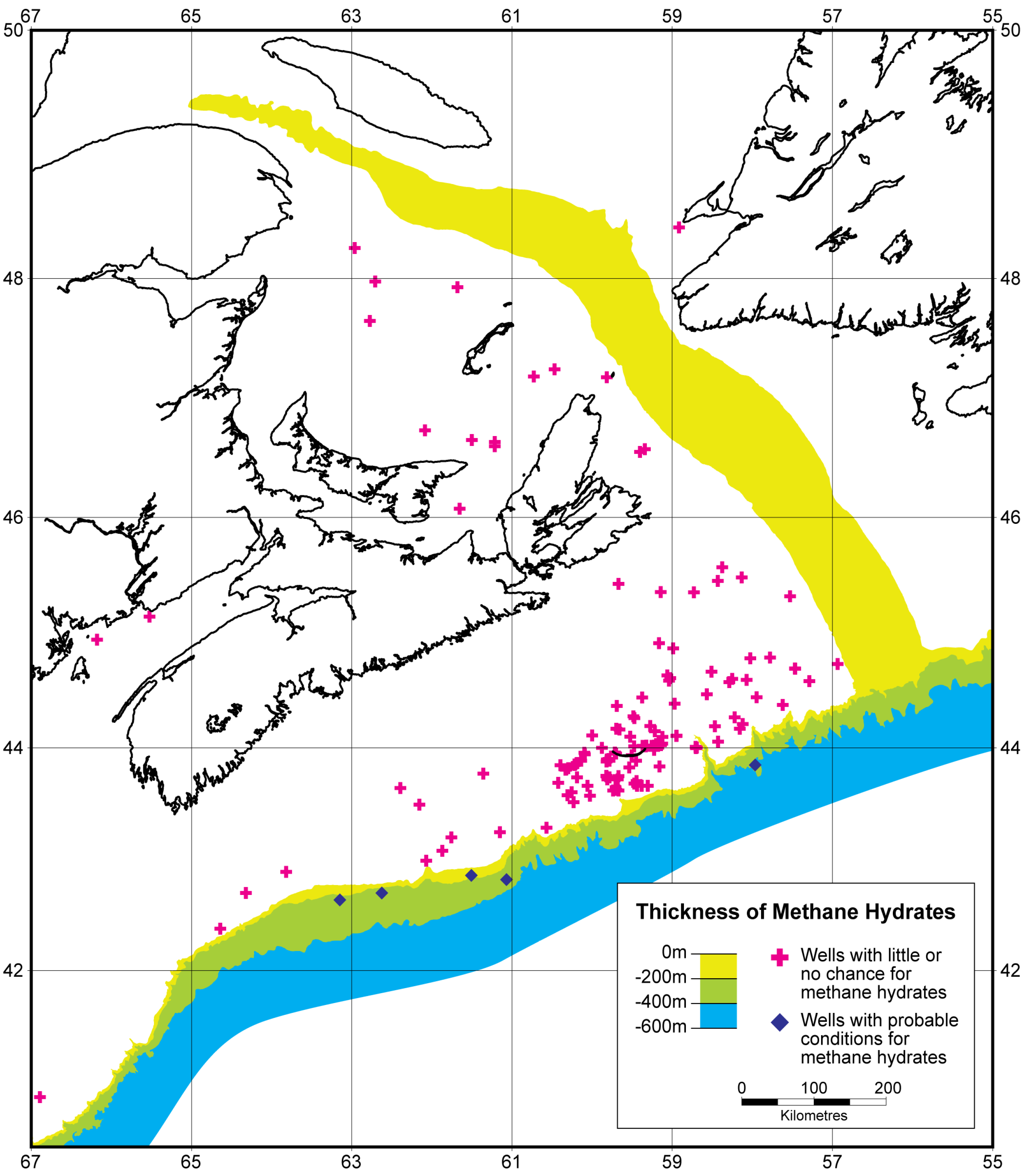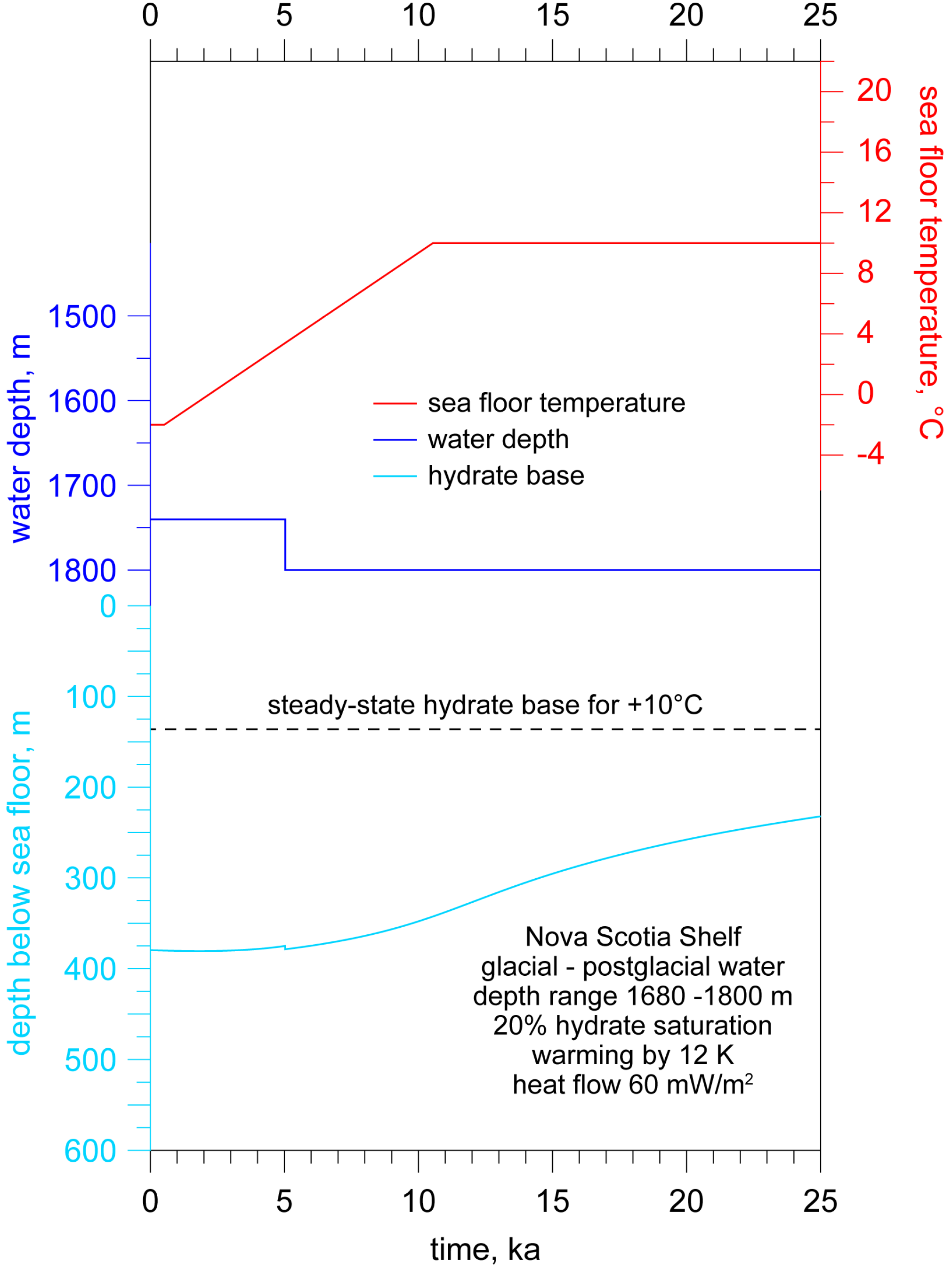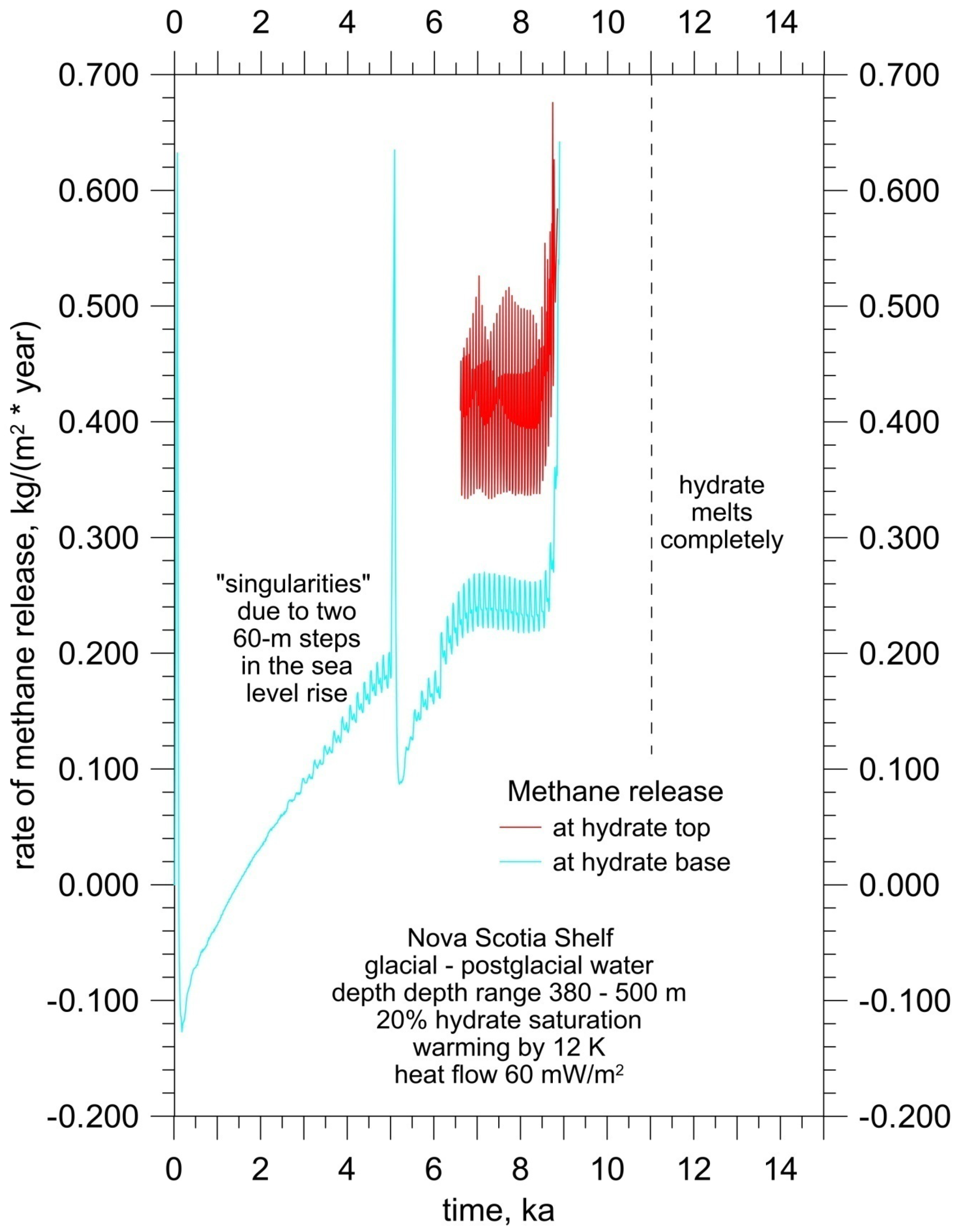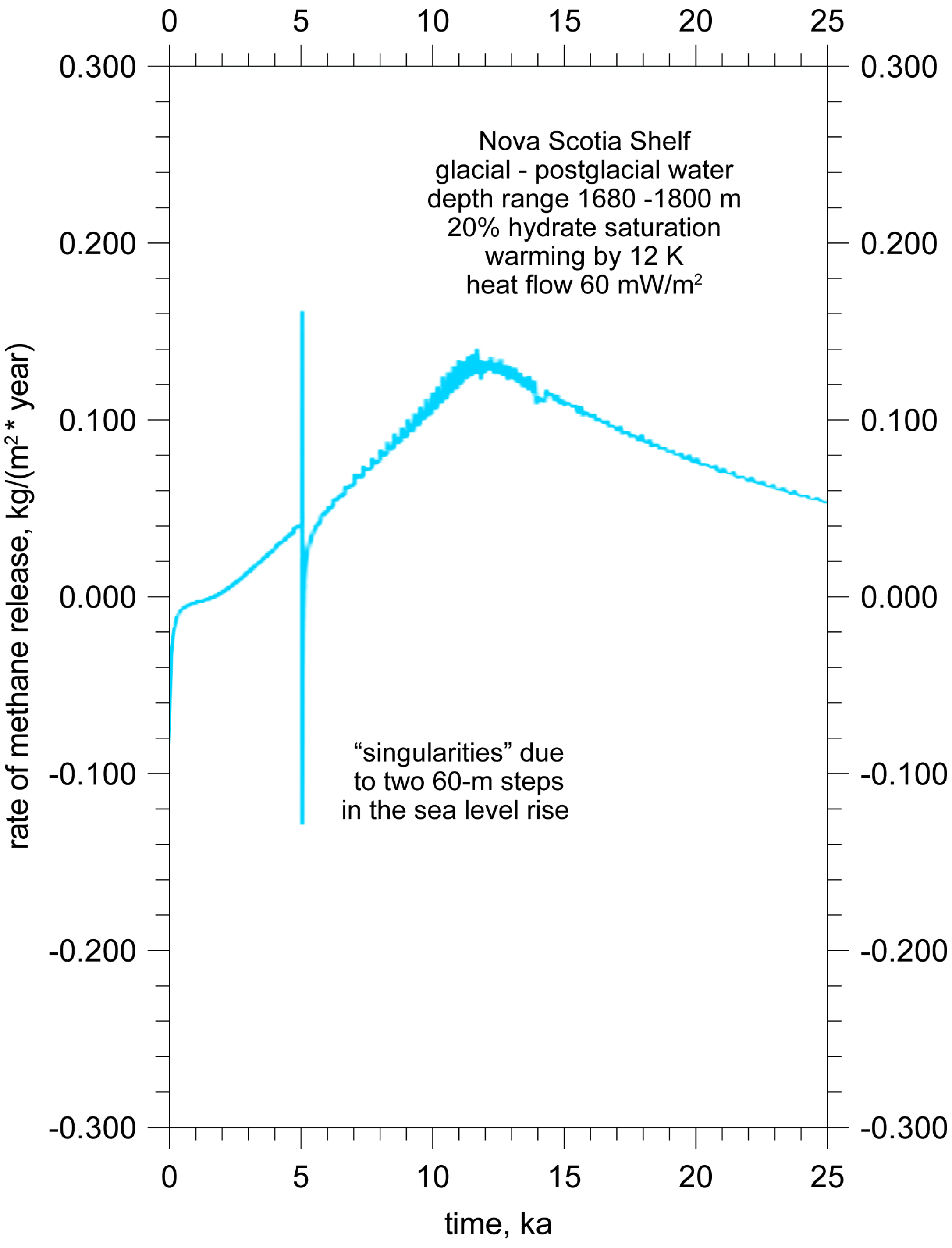7.1. Comparison of Model Predictions to Observed and Inferred GH Occurrences
Several studies have employed a variety of models to infer the future response of marine GH’s to anticipated future climate including a general warming that results in an increase of sea bottom temperature, both generally [
9,
16] or regionally, at a variety of scales [
10,
17,
18]. These models investigate the effects of rising ocean water temperatures on future marine gas hydrate stability with the intention of characterizing the future conditions under which methane release and climate-forcing feedback might occur. In contrast our models herein, which are more sophisticated than [
10] but less so than [
16,
17], calculate the history of three marine gas hydrate settings on Canadian continental margins of the Atlantic and Pacific oceans during the last ~3.0 Myrs, with a focus on their history since ~14 kyrs and projected ~11.5 kyrs into the future when the current interglacial cyclic is inferred to end. Like some previous work [
10] our model study is focused primarily on the history of the gas hydrate stability zone and its changes in response to climatic cycles both in the past and the future where they may be influenced by anthropogenic effects. Unlike other previous work [
16,
17] our model permits only that we infer the maximum potential volumes of methane sequestered or released from gas hydrates in response to climate cycles, based on the changes in the thickness of the gas hydrate stability zone. Our models illustrate effectively the variable history of the gas hydrate stability zone in response to variations in water depth and sea floor temperatures that are themselves influenced by ocean currents. We are, therefore cautious with respect to inferring any climate or oceanographic effects of gas hydrate stability zone dynamics, except where our models illustrate that suggest that the enthalphy of dissociation and the thermal inertia of the sea floor suggest strongly that gas hydrate stability zone dynamics respond to changes in climate and ocean bottom temperature as opposed to driving them as suggested by the clathrate gun hypothesis [
1,
2,
3,
4].
All three of our ocean margin models use inferred sea bottom temperatures and water column variations in response to glacial-interglacial cyclicity to successfully predict the current GH base consistent with observed or inferred GHs on the three oceanic margins studied. The models indicate that marine GH hydrate occurrences are locally dynamic features and the formation age and the potential methane resource volume depend significantly on the dynamics of the ocean-atmosphere system. Our models permit us to predict separately the, past, present and future responses of the GH stability zone as it responds to both natural (glacial-interglacial) and anthropogenic (climate change) forcing. On the convergent Pacific Margin, where GH is inferred pervasive the predicted GH base in deeper water is similar to previous observations from wells and previous models [
10], but about 30 m deeper than the inferred base of the BSR. In deeper water the model suggests that GH have persisted there since the end of the last glacial. The shallow Pacific Margin model predicts that GHs initially dissociated completely in ~400 m water depth within ~2 kyrs the end of the last glacial because they dissociated from both the top and base of the GH layer due to the effects of sea bottom warming, but that GHs reformed after the second sea level rise 9 kyrs ago, to reach ~20 mbsf and they have thinned subsequently only slightly. Therefore we predict that Pacific Margin GHs in water depths less than ~500 m will have a younger formation age and a different history from those underlying the deeper Pacific continental shelf.
In comparison to the size of the GH stability region, GH occurrences are inferred to be rare and localized on the passive Labrador and Nova Scotia margins. BSR’s occur there occur consistently between ~400 ms and 500 ms below the seafloor, and rarely as low as 600 ms below the sea floor, where water columns are currently ~620–2550 m and sea bottom temperatures are between 0 °C and 10 °C [
14,
15]. Our models correctly predict an absence of GHs in the shallow, <500 m, Scotian shelf. They also predict persistent GH stability on the colder shallow Labrador shelf, where BSRs are observed rarely in water depths ~620 m [
15]. Model of the deeper settings predict the current GH stability zone base between ~650 mbsf and 670 mbsf where current sea floor temperatures are 0–4 °C on the Labrador Margin and ~300 mbsf, where current sea floor temperatures are ~10 °C on the Scotian Margin. The model GH base occurs deeper than the current equilibrium depth because GH formed during the last glacial are still not in equilibrium with the modern environment. The Scotian Margin model appears consistent with Mohican Channel BSR and OBS data, which exhibits a fast-slow transition at comparable depth [
15]. The Labrador model GH base appears deeper than common BSRs, ~250–445 mbsf, but it is generally similar the deepest BSR on that margin.
We inferred that the Scotian Margin GHs are relict from the last glacial, since GHs formed in equilibrium with current sea bottom temperatures are not be expected below ~130 mbsf The depth difference between model predictions on the Labrador Margin may result from any or a combination of: insufficient gas supply—as BSR are rare offshore Labrador; the age when Labrador GHs formed—as current GH base equilibrium is shallower than models relict GHs layers from the last glacial; or incorrect model assumptions. Future predictions of GH at the natural end of the current interglacial differ among the three settings because all depend significantly on sea bottom temperatures which differ among the regions studied.
7.2. Comparison of Methane Release Rates
Over time, increasing sea bottom temperature tends to reduce GH stability. The temperature change effects at the sea bottom are damped and attenuated by thermal inertia below the sea floor and phase change enthalpies. Temperature is the predominant control on GH formation and dissociation. Typically the effects are protracted, especially when GH is stable in the water column and dissociation occurs only at the GH layer base. Thus GHs on the deep Scotian slope are currently thicker than expected if they were in equilibrium. In contrast the phase change rates are accelerated significantly when GH layers dissociate from both the base and the top, when the upper GH stability limit migrates below the sea floor. Generally, as shown by the shallow Pacific and Atlantic margin models we observe the complete disappearance of GHs under these conditions on time scales of 2–9 kyrs.
In general, all three deep water models (>1300 m) are characterized by an initial deepening of GHSZ in response to sea level rise that suppresses methane release. This lasts about 2 kyrs generally. Subsequently, thermal effects predominate and annual methane release rate increases with time. As a result the past and current dissociation rates are variable and depend on the combination of temperature predominantly, influenced also by pressure effects, more due to water depth setting than sea level rise. Methane release rates from the deep Labrador Margin are the lowest and, depending on bottom temperature model, they are less than a tenth to a half that from the Pacific Margin. The highest deep water methane release rates are from the Scotian Margin, where the deep continental shelf and slope are influenced by a warm ocean current. Methane release rates there are generally twice that of the Pacific Margin and 10–100 times that from the Labrador Margin, depending on thermal history.
Over time, as the models approach equilibrium, the methane release rate stabilizes or declines. This change occurs first on the Pacific Margin (
Figure 7), where peak methane release rates of about 0.065 kg m
−2 yr
−1 began to decline about ~12 kyrs ago, well before the second sea level rise step. Subsequently the annual rate declines to ~0.020 kg m
−2 yr
−1 currently. Initial sea level rise delays the onset of methane liberation from the deep Labrador Margin also, for ~2 kyrs after the onset of the interglacial (
Figure 14). Deep Labrador methane release peaked at 0.007–0.030 kg m
−2 yr
−1 depending on bottom temperature model (
Figure 14). Subsequently methane release resumes at a nearly constant rate from 0.010 to 0.030 kg m
−2 yr
−1, depending on thermal model, until today. On the Scotian Margin annual methane release rates increased throughout the interglacial to 0.13 kg m
−2 yr
−1 but began to decline to current annual rates of 0.110 kg m
−2 yr
−1 about 2 kyrs ago (
Figure 19).
When projected into the future, the deep water models for all three regions illustrate that future methane release depends critically on ocean bottom temperatures. Regardless of setting the rates increase if the sea bottom temperature increases. On both the Pacific and Labrador margins, where the effects are most likely to be manifest, the annual dissociation rates increase to maximum values of between 0.175 kg m−2 yr−1 on the deep Pacific Margin and 0.080 kg m−2 yr−1 on the deep Labrador Margin, for the greatest potential ocean bottom warming considered. Should ocean bottom temperatures rise in future the resulting maximum rates in all deep settings could be almost twice current rates inferred for the deep Scotian models.
The results in shallow water, ~400–500 m, differ significantly compared to the deeper settings and amongst themselves. GHs have not been stable on the shallow Scotian Shelf for ~5 kyrs and future temperature history has no significance there (
Figure 18). On the shallow Pacific Margin, the GHs that are present, formed during the interglacial in response to the second sea level rise and they are either essentially stable if sea bottom temperature is constant or they dissociate very rapidly to nearly instantaneously, ~100s of years, if sea bottom temperature rises appreciably (
Figure 5). However the neo-formed GH on the shallow Pacific margin is <20 m thick and they do not represent a significant sequestered methane mass compared to the other settings. Future effects in the shallow Labrador Sea to sea bottom warming are significant, should they occur. If sea bottom temperatures there remain low then the annual methane release rate is both relatively constant and similar to the current value of 0.025 kg m
−2 yr
−1. However a significant warming of the shallow Labrador shelf from 0 °C to 10 °C results in a rapid, 2 kyrs, and large increase of methane release rate to 0.135 kg m
−2 yr
−1, which declines slightly to 0.125 kg m
−2 yr
−1 at the end of the current interglacial.
In summary, the previous annual marine methane release rates are highly variable depending on the water depth setting and sea bottom temperature models. The most significant increases in rate occur where the sea bottom warming is greatest. Where sea bottom temperatures remain constant the rates of methane release are lower, or declining as the system comes to thermal equilibrium. As mentioned above the future warming models employed are inferred to represent a maximum change in sea bottom temperature, and so it unlikely that the methane release rates would exceed those discussed above. Still, our models suggest that methane release from marine GHs occurs at a rate that is an order of magnitude faster than in the terrestrial permafrost environments [
5,
6,
9,
14], due in part to, their thin development adjacent the thermal boundary at the sea floor, in comparison to the buffering effects that both permafrost and greater depth exert on terrestrial gas hydrates.
7.3. Long-Term Glacial-Interglacial Cycles
Marine GHs are also a very large potential reservoir of methane and carbon. There are ~4 to ~5 times more carbon stored in marine than terrestrial GHs. The marine GH reservoir currently contains 500–10,000 giga-tonnes of carbon, with a best current estimate of 1600–2000 Gt, compared to ~400 Gt of carbon in the terrestrial sub-permafrost GH reservoir. However, as illustrated by the difference between GHs inferred on the Canadian and Pacific and Atlantic margins the global estimates of marine GHs may be exaggerated when GH base estimates are compared to actual GH occurrence as indicated by BSRs and other methods [
6,
15].
It is important to consider the potential impact marine GHs might have on the climate-ocean system. The immensity of the marine GH carbon reservoir combined with the rapidity with which marine GHs can dissociate in response to ocean bottom temperature changes and sea level variations suggest that GHs have a significant potential to impact the climate-ocean system. Certainly the size of the marine GH carbon reservoir and the illustrated rapidity of GH dissociation/formation suggests that GH can have a large potential impact on the climate-ocean system, but whether they actually have had an impact is more difficult to infer, primarily because of: uncertainties in the older temperature and sea level histories and the uncertainties regarding what proportion of the potential GHSZ is actually occupied by GHs as illustrated by the contrasts between the common and pervasive BSR on the Canadian Pacific Margin compared to the rate and localized BSR’s on the Canadian Atlantic Margin.
The models and discussion above focused on the more recent interglacial history since ~14 kyrs ago and on the predicted future fate and effects of marine GHs until the end of the current interglacial, ~11.5 kyrs in the future. To consider the potential role of marine GHs in climate and ocean change during the time interval from the late Pliocene to the Present requires the consideration of a much longer model interval. This is computationally possible with our model, but our previous analysis of the uncertainties in temperature history make the inference of the longer term effects of both the 41 kyrs and 100 kyrs glacial interglacial cycles uncertain. Our previous GH stability simulations in Beaufort Mackenzie region and the Canadian Arctic Archipelago [
6], began in the Tertiary, but the results showed that the consideration of a long history (14.0 to 1.0 Myrs ago) had an insignificant effect on the Holocene results, such that the uncertainties attending possible alternative early temperature histories did not result in discernable variations in the current depth to the base of GHs, which is the only observable test of model validity. The extent to which local ground surface temperature (GST) or sea bottom temperature history followed regional and global variations is uncertain, especially for the more distant past. Our previous modeling [
6,
9], explored and tested GH formation and stability sensitivities to uncertainties in the early GST forcing model prior to the onset of the 100 kyrs glacial cycles. That sensitivity analysis compared a “warm” linearly declining, surface temperature of 10 °C, 3 Myrs ago against “cold” GST models that included 41 kyrs glacial cycles. The results differ slightly in the calculated permafrost base, but only for model intervals prior to ~1 Myrs ago. The Arctic GHs formed mainly in sub-permafrost conditions and there the model predictions for both current permafrost and GHs can be used to test model predictions. The marine GH cases considered here are controlled by sea bottom temperatures in the −2 °C to 10 °C range. Still it is useful to consider the model results for times prior to the last interglacial and a comparison of our previous Arctic models [
9] to models are shown in
Figure 20.
Figure 20.
Comparison of the GH models for illustrated climate histories for both (1) the Canadian offshore
vs. (2) the Canadian Arctic history. Curves 3 and 4 illustrate the top and bottom of the onshore Arctic GHs from [
9], respectively. Curves 6 and 7 illustrate the GH layer top and bottom (below sea level) for a typical marine gas hydrate. Curve 8 illustrates the average sea bottom temperature required for GH stability below a 400 m water column assuming an average marine heat flow. The insert illustrates the GH layer top and bottom history for the shallow Nova Scotia shelf where water columns are 400–500 m thick (insert).
Figure 20.
Comparison of the GH models for illustrated climate histories for both (1) the Canadian offshore
vs. (2) the Canadian Arctic history. Curves 3 and 4 illustrate the top and bottom of the onshore Arctic GHs from [
9], respectively. Curves 6 and 7 illustrate the GH layer top and bottom (below sea level) for a typical marine gas hydrate. Curve 8 illustrates the average sea bottom temperature required for GH stability below a 400 m water column assuming an average marine heat flow. The insert illustrates the GH layer top and bottom history for the shallow Nova Scotia shelf where water columns are 400–500 m thick (insert).
Temperatures were significantly, perhaps ~10 °C, higher during the interval between 14 Myrs ago and 3 Myrs ago when the 41 kyrs cycles begins and GHs would be present only where water column were >1 km on the Pacific and Labrador margins and >2 km on the Scotian Slope.
Figure 20 indicates the general lack of hydrate stability conditions for most of the interval between 3.0 Myrs ago and 0.9 Myrs ago, prior to when the 100 kyrs glacial-interglacial cycles begin. Models show that the 20.5 kyrs long interglacial during the 41 kyrs glacial-interglacial cycles are sufficiently long that most marine GHs dissociate with each interglacial warming. It is therefore unlikely that GHs persisted prior to ~1.5 Myrs where water columns were <0.4 km. The analysis of the more distant past is complicated by uncertainties in both temperature and water column histories. The current temperature history uncertainty is too large to permit us to make definite and quantitative answers regarding the past effects of GHs on the climate-ocean system.
Our models show that GH stability reacts quickly to water column pressure effects but much more slowly to sea bottom temperature changes. Therefore models suggest qualitatively that GH destabilization is both responsive and progressive as sea levels fall during glacial intervals. This argues against a “catastrophic” or synchronized GH auto cyclic control on glacial-interglacial intervals. It is computationally possible; but, unfortunately in no way verifiably to analyze the interactions and impacts that marine GHs may have had prior to the current interglacial because of uncertainties in temperature and pressure history constraints. Thus we have the capability, but no confidence, that we can quantitatively contribute to questions regarding relationships among climate, glacio-eustatic sea level and marine GHs without improved temperature and water column histories. Our analysis suggests that models invoking “catastrophic” marine gas hydrate stability changes as a mechanism for climate change or oceanic anoxia are speculative, but qualitatively unsupported by our current models.
Several additional factors should be considered in models that predate the current interglacial. Warming water expands volumetrically; however, the resulting pressure is reduced by the accompanying decrease of water density with increasing temperature. Climate warming will reduce ice volumes and increase ocean volumes with higher sea levels increasing GH stability. However, it is generally inferred that continental ice sheets grow slowly compared to their melting and the rapidity of pressure effects in our models suggest that oceanic methane flux during eustatic sea level falls would be significantly delayed or retarded. Rather GH dissociation should follow falling sea level quite closely. This is contrary to the “clathrate gun” hypothesis, especially if this were accompanied by a lowering of sea bottom temperature accompanying glacial climate cycles. Thus, the situation is complex and highly dependent on the specifics of water depth, sea bottom temperatures and the actual occurrence of GHs opposed to their theoretical stability, which depends on the petroleum system. As such we must await better constraints of continental shelf petroleum system, thermal and water column histories to verifiably produce meaningful models prior to the current interglacial.
